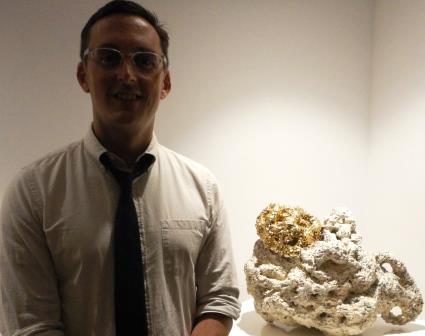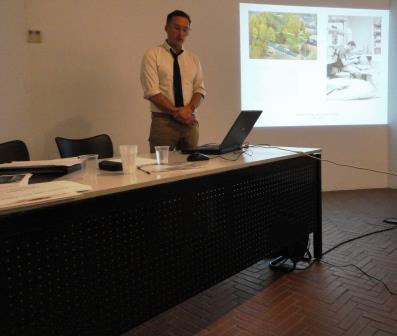Els treballs del ceramista nord-americà Andrew Cassto (Ohio, USA, 1977) tenen una profunda base teòrica una gran dosi d’investigació. Finalista de la 7a biennal de ceràmica del Vendrell, fa uns mesos vam intercanviar tot un seguit de correus electrònics i finalment li vaig fer l’entrevista que ara teniu aquí.
1. What were your main influences ? 2. What do you think are your sources of inspiration ?
I’ll talk about these two together, if that’s ok. I generally consider three main areas of influence/inspiration in my work: The physical language of geological processes, such as erosion, coral reefs, invasive plant species, or various rock configurations observed in nature all impact how I construct or work in the studio. I enjoy the elemental nature of clay as earth, and the microcosmic/macrocosmic perspective which emerges when one works in the manner I do. On a conceptual level, I’m intrigued by the ability of clay to be frozen in moments of collapse, or failure, and I often consider parallels between these moments of near destruction in the physical nature of my work, and in the day to day nature of life. My goal is to find beauty in these seemingly precarious situations. I use the gold luster as way to signify the preciousness of these moments, and their importance to me in the work, as a metaphor for how I feel about them in life as well.
I also am a great admirer of DJ sampling techniques, particularly in hip hop music of the 1980’s, prior to modern day copyright legislature, and in the generative music of composers such as Steve Reich or Brian Eno. I enjoy the tangental contextual relationships that occur when elements with existing contexts and identities are placed in conjunction with each other. It’s my goal to use this same form of “visual sampling” in my work, and to construct new hybrid realities in my work in this same fashion.
Artistically, I’ve always been influenced by “Earth Art” sculptors from the 1960’s and 70’s, as well as the Minimalist movement, although it’s not always apparent in my work. I find the work of Robert Smithson, Donald Judd, Anne Truit Andy Goldsworthy, Richard Long, Eva Hesse, and Frank Stella all to be very important to my artistic upbringing. I also currently love the prose of novelist Jesse Ball, who writes stories which flow from one scene or moment to the next with the traditional details and constraints of place and setting often purposely omitted. They are like dreams on paper. I’ve also been fortunate to work with many talented artists whom I consider important influences as well, some of these mentors have been Susan Chrysler White, David O. Dunlap, and Michael Perrone, all of which were faculty members in the Painting and Drawing program at The University of Iowa when I was a graduate student in Ceramics there.
3. Experimentation is one of the foundations of your work, how do you decide which line to follow?
I generally follow the line of experimentation that doesn’t fall apart. I have a lot of studio failures, which can be really disheartening, so sometimes the question of which direction to follow takes care of itself. I am interested in some results over others, however, and I’m partial to work that feels the most natural, and organic, as if it wasn’t made by me at all. Often the pieces I like the best are the ones that were the most surprising, and the least planned. I do my best to take myself out of the equation whenever possible, and generally this is a benchmark of success for me.
4. Is the color range using accidental or deliberate? Does it mean anything special?
I like bright color, and I want the work to vibrate with intensity and saturation. I also consider some of the color choices to be a deliberate link with the hip hop music culture I talked about previously, i.e., florescent spray paint colors often seen on train cars and walls in cities to create the most noticeable pieces possible. To me it’s a nod to the hybridity of culture, and to the remnants of my experiences present in the work.
5. Your work explores the relationship among painting, sculpture and installation. How does your work –not only ceramic– is going on in the coming years?
I’ve been making the same series of work for several years now, and I’m starting to feel the need to branch out some. In the past, the “assemblages” I’ve created are all still unified with a layer of casting slip, effectively fusing them together as units, or moments. I like this way of working, but I’m thinking of making the various parts more disparate, and less attached to each other. This will naturally push the work more in the direction of installation, which is fine with me, and often how I prefer to work regardless, but this would be a shift in the density of the pieces in the installation; one that would grant the viewer more access to certain elements of the work, and leave some things more discernible to the eyes of the audience.

